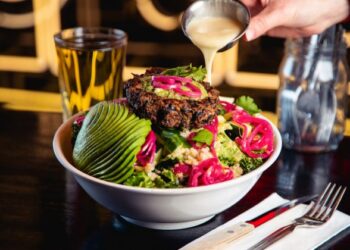Have you ever been detracted by poor design, confused dish descriptions, and terrible imagery on a menu? If the answer’s yes, you know how powerful this tool can be.
It is like a portal to the world of yumminess. And it helps you answer, “Have I come to the right place?” at merely the first glance.
While a boring menu might not turn all the customers away, it can certainly shift the pressure to your food and customer service. And that is a bigger gamble. It is why when experts list the top ways to boost a restaurant’s bottom line, they never miss out on a well-designed menu!
So, if you’re ready to tantalize your guests’ taste buds just by describing your hot sellers, keep these tips in mind.
1. Set the Mood with Images
You first eat with your eyes, remember? And when you’re paying big money for food, you don’t want to risk it. It is where images come into play. Studies reveal that a beautiful picture can increase the sale of an item by 30%. So, garnish your menu with the most tempting images of your dishes.
But you can’t use mediocre images. You need high-quality, well-lit, eye-catching shots of your dishes. So, hire a food photographer and let them handle it.
At the same time, if you’re a startup with a limited budget, using stock photos & images is a good option too. Regardless, ensure the images don’t look like they came from a jumble sale.
2. Follow the Golden Triangle Rule
Eye movement patterns (sounds too science-y) are crucial when placing your most running, high-profitable dishes on the card.
According to menu engineering experts, a person’s eyes are naturally set on the center of the page when they first look at it. Then comes the top right and the top left (in that order). It is what the Golden Triangle is all about.
Other claims suggest that diners read menus like books – they start at the top left. And some just look at the first thing on the card and decide.
So, cover your bases. Use these three crucial spots to list the high-margin items and watch the profits grow.
3. Always Put Food First
Restaurants are a treasure box of creative minds. Chefs artfully plate dishes, bartenders mix tipple with finesse, and sommeliers pair wines with expertise. It’s an overflow of creativity.
But when all these great minds come together to design the menu, they often get caught up in making it look pretty.
Sometimes it means scrapping entire dishes off the menu or making eleventh-hour changes to items to make the menu look more presentable. But why limit choices? Why not focus on your specialties, curate a list of dishes that go well together, and consider your cost-to-profit ratio before the design?
Trust us; your guests will always put food first, and so should you.
4. Ditch the Dollar Sign
A study at Cornell showed that people who ordered food from a menu without a dollar sign spent more money than those who ordered from a menu with a dollar sign. It is because “$” triggers a negative feeling about spending too much money. So, skip it.
Your guests know what the figure next to the dish means. Also, never put your prices in a single column. It instantly leads to comparisons, and that’s not good for your profits.
Another important price-related tip is to keep the font simple with numbers. You don’t want your ‘9’ looking like an ‘8’ or a ‘3’. It can be confusing and lead to customer dissatisfaction.
5. Enhance Visual Direction with Shapes and Colors
If you’ve just started an eatery, remember that first-timers look for the star menu items on the card. Why not highlight them? You can do it by using shapes and colors.
For example, you can use a square to highlight the bestseller or a circle for value dishes or those with deals. Also, don’t forget to add color cues to draw attention. Colors like red and orange can help increase impulse orders.
But don’t overdo it. Too many shapes and shades can confuse your customers. If you can, let a graphic designer work on the design element. They’ll know where to put what, so your menu stays with the guest for a long. They’ll also keep your brand’s color scheme and fonts intact.
6. Sometimes, Less is More
Menu editors often commit a cardinal sin – they add too many details to the card. You may want to provide information on the dish and its origin. But keep it minimalistic.
Diners are often intimidated by long descriptions. And too many details can confuse them and make them skip the menu altogether.
So, save space by using bullet points or brief two-liners for the description.
Also, avoid using technical terms or foreign words to describe a dish unless necessary. Instead of calling something a ‘Ratatouille,’ you can call it a ‘vegetable medley.’ Also, your customer doesn’t know what ‘Gastrique’ means, so replace it with something easy to understand and easier to visualize, like ‘caramelized syrup.’
7. Ease the Burden of Choice
Customers go through lengthy discussions about “Hey, where to eat tonight?” And, when they finally settle on your restaurant and come to the menu, they get confused again – “Oh Lord, what should I eat?”
You don’t want to give them more options than they can handle; otherwise, they’ll get overwhelmed and order their default items every time. And if one dish has two flavor options, they’ll compare it to the last detail. Food is supposed to be enjoyed and not overthought.
Also, the longer it takes for your diner to decide what to order, the lesser numbers of tables you serve in a day.
So, curate the menu with only your signature items and some crowd-pleasers. You can also offer combo meals and specials to make it easier for them.
Conclusion
Designing your restaurant menu is an art – it’s more than just a list of dishes. It’s about setting the right mood, making ordering decisions easier for your guests, and, most importantly, triggering positive emotions.
So, make sure you use the right colors, shapes, and fonts to create a harmonious menu that speaks the language of your brand.
Also, make sure you edit the menu and keep it clutter-free. Your guests will thank you for that!



